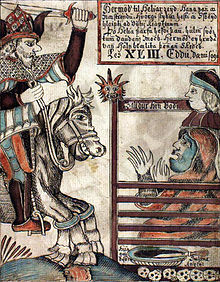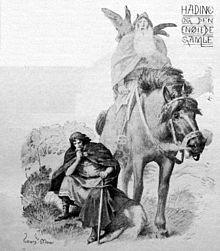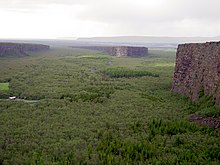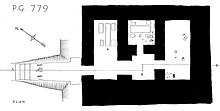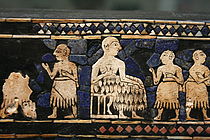The Viking connection to
the aspect of the eight-legged horse must be absolute in the draw of bridge to
past. The side to side action of horses
in war is indeed the grant of that four-legged chase to harness the next
paragraph to picture complete:
To engage the Viking as
World renowned is to appreciate the ship.
A device of times to oceans the announced is merely the system to the
sky and the traveling to the seas as oars were the template of that era. As tides rose and beaches became landings it
is perhaps as simple as complex; is Occam’s razor by choice to the best tool as
by application to the quick of flame to the story of the liver as the body of
absorption measures accuracy to chapter and verse being word to mouth instead
of foot to the 12 inch rule removing the triplex of just numbers and returning
to the route as units to simply explain the knot itself.
Sleipnir
From Wikipedia, the free encyclopedia
Jump to navigation
Jump to search
In
Norse mythology,
Sleipnir (
Old Norse "slippy"
[1] or "the slipper"
[2]) is an eight-legged
horse ridden by
Odin. Sleipnir is attested in the
Poetic Edda, compiled in the 13th century from earlier traditional sources, and the
Prose Edda, written in the 13th century by
Snorri Sturluson. In both sources, Sleipnir is Odin's steed, is the child of
Loki and
Svaðilfari, is described as the best of all horses, and is sometimes ridden to the location of
Hel. The
Prose Edda contains extended information regarding the circumstances of Sleipnir's birth, and details that he is grey in color.
Sleipnir is also mentioned in a riddle found in the 13th century
legendary saga Hervarar saga ok Heiðreks, in the 13th-century legendary saga
Völsunga saga as the ancestor of the horse
Grani, and book I of
Gesta Danorum, written in the 12th century by
Saxo Grammaticus,
contains an episode considered by many scholars to involve Sleipnir.
Sleipnir is generally accepted as depicted on two 8th century
Gotlandic image stones: the
Tjängvide image stone and the
Ardre VIII image stone.
Scholarly theories have been proposed regarding Sleipnir's potential connection to
shamanic practices among the
Norse pagans. In modern times, Sleipnir appears in
Icelandic folklore as the creator of
Ásbyrgi, in works of art, literature, software, and in the names of ships.
Attestations
Poetic Edda
In the
Poetic Edda, Sleipnir appears or is mentioned in the poems
Grímnismál,
Sigrdrífumál,
Baldrs draumar, and
Hyndluljóð. In
Grímnismál,
Grimnir
(Odin in disguise and not yet having revealed his identity) tells the
boy Agnar in verse that Sleipnir is the best of horses ("Odin is the
best of the
Æsir, Sleipnir of horses").
[3] In
Sigrdrífumál, the
valkyrie Sigrdrífa tells the hero
Sigurðr that
runes should be cut "on Sleipnir's teeth and on the sledge's strap-bands."
[4] In
Baldrs draumar, after the Æsir convene about the god
Baldr's bad dreams, Odin places a
saddle on Sleipnir and the two ride to the location of
Hel.
[5] The
Völuspá hin skamma section of
Hyndluljóð says that Loki produced "
the wolf" with
Angrboða, produced Sleipnir with
Svaðilfari, and thirdly "one monster that was thought the most baleful, who was descended from
Býleistr's brother."
[6]
Prose Edda
An illustration of Odin riding Sleipnir from an 18th-century Icelandic manuscript.
An 18th century Prose Edda manuscript illustration featuring Hermóðr upon Sleipnir (left), Baldr (upper right), and Hel (lower right).
In the
Prose Edda book
Gylfaginning, Sleipnir is first mentioned in chapter 15 where the enthroned figure of
High says that every day the Æsir ride across the bridge
Bifröst, and provides a list of the Æsir's horses. The list begins with Sleipnir: "best is Sleipnir, he is Odin's, he has eight legs."
[7] In chapter 41, High quotes the
Grímnismál stanza that mentions Sleipnir.
[8]
In chapter 43, Sleipnir's origins are described.
Gangleri (described earlier in the book as King
Gylfi
in disguise) asks High who the horse Sleipnir belongs to and what there
is to tell about it. High expresses surprise in Gangleri's lack of
knowledge about Sleipnir and its origin. High tells a story set "right
at the beginning of the gods' settlement, when the gods established
Midgard and built
Val-Hall"
about an unnamed builder who has offered to build a fortification for
the gods in three seasons that will keep out invaders in exchange for
the goddess
Freyja, the
sun, and the
moon.
After some debate, the gods agree to this, but place a number of
restrictions on the builder, including that he must complete the work
within three seasons with the help of no man. The builder makes a single
request; that he may have help from his stallion
Svaðilfari,
and due to Loki's influence, this is allowed. The stallion Svaðilfari
performs twice the deeds of strength as the builder, and hauls enormous
rocks to the surprise of the gods. The builder, with Svaðilfari, makes
fast progress on the wall, and three days before the deadline of summer,
the builder was nearly at the entrance to the fortification. The gods
convene, and figured out who was responsible, resulting in a unanimous
agreement that, along with most trouble, Loki was to blame.
[9]
The gods declare that Loki would deserve a horrible death if he
could not find a scheme that would cause the builder to forfeit his
payment, and threatened to attack him. Loki, afraid, swore oaths that he
would devise a scheme to cause the builder to forfeit the payment,
whatever it would cost himself. That night, the builder drove out to
fetch stone with his stallion Svaðilfari, and out from a wood ran a
mare. The mare neighed at Svaðilfari, and "realizing what kind of horse
it was," Svaðilfari became frantic, neighed, tore apart his tackle, and
ran towards the mare. The mare ran to the wood, Svaðilfari followed, and
the builder chased after. The two horses ran around all night, causing
the building work to be held up for the night, and the previous momentum
of building work that the builder had been able to maintain was not
continued.
[10]
When the Æsir realize that the builder is a
hrimthurs,
they disregard their previous oaths with the builder, and call for
Thor. Thor arrives, and kills the builder by smashing the builder's
skull into shards with the hammer
Mjöllnir. However, Loki had "such dealings" with Svaðilfari that "somewhat later" Loki gave birth to a grey
foal with eight legs; the horse Sleipnir, "the best horse among gods and men."
[10]
In chapter 49, High describes the death of the god
Baldr.
Hermóðr
agrees to ride to Hel to offer a ransom for Baldr's return, and so
"then Odin's horse Sleipnir was fetched and led forward." Hermóðr mounts
Sleipnir and rides away. Hermóðr rides for
nine nights in deep, dark valleys where Hermóðr can see nothing. The two arrive at the river
Gjöll and then continue to Gjöll bridge, encountering a maiden guarding the bridge named
Móðguðr.
Some dialogue occurs between Hermóðr and Móðguðr, including that
Móðguðr notes that recently there had ridden five battalions of dead men
across the bridge that made less sound than he. Sleipnir and Hermóðr
continue "downwards and northwards" on the road to Hel, until the two
arrive at Hel's gates. Hermóðr dismounts from Sleipnir, tightens
Sleipnir's
girth,
mounts him, and spurs Sleipnir on. Sleipnir "jumped so hard and over
the gate that it came nowhere near." Hermóðr rides up to the hall, and
dismounts from Sleipnir. After Hermóðr's pleas to
Hel to return Baldr are accepted under a condition, Hermóðr and Baldr retrace their path backward and return to
Asgard.
[11]
In chapter 16 of the book
Skáldskaparmál, a
kenning given for Loki is "relative of Sleipnir."
[12] In chapter 17, a story is provided in which Odin rides Sleipnir into the land of
Jötunheimr and arrives at the residence of the
jötunn Hrungnir.
Hrungnir asks "what sort of person this was" wearing a golden helmet,
"riding sky and sea," and says that the stranger "has a marvellously
good horse." Odin wagers his head that no horse as good could be found
in all of Jötunheimr. Hrungnir admitted that it was a fine horse, yet
states that he owns a much longer-paced horse;
Gullfaxi.
Incensed, Hrungnir leaps atop Gullfaxi, intending to attack Odin for
Odin's boasting. Odin gallops hard ahead of Hrungnir, and, in his, fury,
Hrungnir finds himself having rushed into the gates of Asgard.
[13] In chapter 58, Sleipnir is mentioned among a list of horses in
Þorgrímsþula: "Hrafn and Sleipnir, splendid horses [...]".
[14] In addition, Sleipnir occurs twice in kennings for "
ship" (once appearing in chapter 25 in a work by the
skald Refr, and "sea-Sleipnir" appearing in chapter 49 in
Húsdrápa, a work by the 10th century skald
Úlfr Uggason).
[15]
Hervarar saga ok Heiðreks
In
Hervarar saga ok Heiðreks, the poem
Heiðreks gátur contains a riddle that mentions Sleipnir and Odin:
- 36. Gestumblindi said:
- "Who are the twain
- that on ten feet run?
- three eyes they have,
- but only one tail.
- Alright guess now
- this riddle, Heithrek!"
- Heithrek said:
- "Good is thy riddle, Gestumblindi,
- and guessed it is:
- that is Odin riding on Sleipnir."[16]
Völsunga saga
In chapter 13 of
Völsunga saga, the hero
Sigurðr is on his way to a wood and he meets a
long-bearded old man
he had never seen before. Sigurd tells the old man that he is going to
choose a horse, and asks the old man to come with him to help him
decide. The old man says that they should drive the horses down to the
river Busiltjörn. The two drive the horses down into the deeps of
Busiltjörn, and all of the horses swim back to land but a large, young,
and handsome grey horse that no one had ever mounted. The grey-bearded
old man says that the horse is from "Sleipnir's kin" and that "he must
be raised carefully, because he will become better than any other
horse." The old man vanishes. Sigurd names the horse
Grani, and the narrative adds that the old man was none other than (the god)
Odin.
[17]
Gesta Danorum
"Hadingus and the Old Man" (1898) by
Louis Moe.
Sleipnir is generally considered as appearing in a sequence of events described in book I of
Gesta Danorum.
[18]
In book I, the young
Hadingus
encounters "a certain man of great age who had lost an eye" who allies
him with Liserus. Hadingus and Liserus set out to wage war on Lokerus,
ruler of
Kurland.
Meeting defeat, the old man takes Hadingus with him onto his horse as
they flee to the old man's house, and the two drink an invigorating
draught. The old man sings a prophecy, and takes Hadingus back to where
he found him on his horse. During the ride back, Hadingus trembles
beneath the old man's
mantle,
and peers out of its holes. Hadingus realizes that he is flying through
the air: "and he saw that before the steps of the horse lay the sea;
but was told not to steal a glimpse of the forbidden thing, and
therefore turned his amazed eyes from the dread spectacle of the roads
that he journeyed."
[19]
In book II,
Biarco mentions Odin and Sleipnir: "If I may look on the awful husband of
Frigg, howsoever he be covered in his white shield, and guide his tall steed, he shall in no way go safe out of
Leire; it is lawful to lay low in war the war-waging god."
[20]
Archaeological record
Two of the 8th century
picture stones from the island of
Gotland,
Sweden depict eight-legged horses, which are thought by most scholars to depict Sleipnir: the
Tjängvide image stone and the
Ardre VIII image stone.
Both stones feature a rider sitting atop an eight-legged horse, which
some scholars view as Odin. Above the rider on the Tjängvide image stone
is a horizontal figure holding a spear, which may be a
valkyrie, and a female figure greets the rider with a cup. The scene has been interpreted as a rider arriving at the world of the dead.
[21] The mid-7th century
Eggja stone bearing the
Odinic name haras (
Old Norse 'army god') may be interpreted as depicting Sleipnir.
[22]
Detail of figure riding an eight-legged horse on the Tjängvide image stone
The Ardre VIII image stone
Theories
John Lindow
theorizes that Sleipnir's "connection to the world of the dead grants a
special poignancy to one of the kennings in which Sleipnir turns up as a
horse word," referring to the skald Úlfr Uggason's usage of
"sea-Sleipnir" in his
Húsdrápa, which describes the funeral of
Baldr. Lindow continues that "his use of Sleipnir in the kenning may
show that Sleipnir's role in the failed recovery of Baldr was known at
that time and place in Iceland; it certainly indicates that Sleipnir was
an active participant in the mythology of the last decades of
paganism." Lindow adds that the eight legs of Sleipnir "have been
interpreted as an indication of great speed or as being connected in
some unclear way with cult activity."
[21]
Hilda Ellis Davidson
says that "the eight-legged horse of Odin is the typical steed of the
shaman" and that in the shaman's journeys to the heavens or the
underworld, a shaman "is usually represented as riding on some bird or
animal." Davidson says that while the creature may vary, the horse is
fairly common "in the lands where horses are in general use, and
Sleipnir's ability to bear the god through the air is typical of the
shaman's steed" and cites an example from a study of shamanism by
Mircea Eliade of an eight-legged foal from a story of a
Buryat shaman. Davidson says that while attempts have been made to connect Sleipnir with
hobby horses
and steeds with more than four feet that appear in carnivals and
processions, but that "a more fruitful resemblance seems to be on the
bier
on which a dead man is carried in the funeral procession by four
bearers; borne along thus, he may be described as riding on a steed with
eight legs." As an example, Davidson cites a funeral
dirge from the
Gondi people in
India as recorded by
Verrier Elwin, stating that "it contains references to
Bagri Maro,
the horse with eight legs, and it is clear from the song that it is the
dead man's bier." Davidson says that the song is sung when a
distinguished
Muria dies, and provides a verse:
[23]
- What horse is this?
- It is the horse of Bagri Maro.
- What should we say of its legs?
- This horse has eight legs.
- What should we say of its heads?
- This horse has four heads. . . .
- Catch the bridle and mount the horse.[23]
Davidson adds that the representation of Odin's steed as eight-legged
could arise naturally out of such an image, and that "this is in
accordance with the picture of Sleipnir as a horse that could bear its
rider to the land of the dead."
[23]
Ulla Loumand cites Sleipnir and the flying horse
Hófvarpnir as "prime examples" of horses in Norse mythology as being able to "mediate between earth and sky, between
Ásgarðr,
Miðgarðr and
Útgarðr and between the world of mortal men and the underworld."
[24]
The
Encyclopedia of Indo-European Culture theorizes that Sleipnir's eight legs may be the remnants of horse-associated
divine twins found in
Indo-European cultures and ultimately stemming from
Proto-Indo-European religion.
The encyclopedia states that "[...] Sleipnir is born with an extra set
of legs, thus representing an original pair of horses. Like
Freyr and
Njörðr,
Sleipnir is responsible for carrying the dead to the otherworld." The
encyclopedia cites parallels between the birth of Sleipnir and myths
originally pointing to a
Celtic goddess who gave birth to the Divine horse twins. These elements include a demand for a goddess by an unwanted suitor (the
hrimthurs demanding the goddess
Freyja) and the seduction of builders.
[25]
Modern influence
The horseshoe-shaped canyon
Ásbyrgi.
According to Icelandic folklore, the
horseshoe-shaped canyon
Ásbyrgi located in
Jökulsárgljúfur National Park, northern
Iceland was formed by Sleipnir's hoof.
[26] Sleipnir is depicted with Odin on
Dagfin Werenskiold's wooden relief
Odin på Sleipnir (1945–1950) on the exterior of the
Oslo City Hall in
Oslo,
Norway.
[27] Sleipnir has been and remains a popular name for ships in northern Europe, and
Rudyard Kipling's short story entitled
Sleipnir, late Thurinda (1888) features a horse named Sleipnir.
[28][26] A statue of Sleipnir (1998) stands in
Wednesbury,
England, a town which takes its name from the
Anglo-Saxon version of Odin,
Wōden.
[29]
See also
- Helhest, the three-legged "Hel horse" of later Scandinavian folklore
- The "táltos steed", a six-legged horse in Hungarian folklore
- Pegasus, the winged horse of Greek mythology
- Santa Claus's eight flying reindeer.
Notes
 |
Wikimedia Commons has media related to Sleipnir. |
Orchard (1997:151).
- Noszlopy, Waterhouse (2005:181).
References
- Byock, Jesse (Trans.) (1990). The Saga of the Volsungs: The Norse Epic of Sigurd the Dragon Slayer. University of California Press. ISBN 0-520-23285-2
- Ellis Davidson, H. R. (1990). Gods And Myths Of Northern Europe. Penguin. ISBN 0-14-013627-4
- Faulkes, Anthony (Trans.) (1995). Edda. Everyman. ISBN 0-460-87616-3
- Grammaticus, Saxo; Elton, Oliver (1905). The Danish History. New York: Norroena Society. (reprinted in 2005 by BiblioBazaar)
- Hollander, Lee Milton (1936). Old Norse Poems: The Most Important Nonskaldic Verse Not Included in the Poetic Edda. Columbia University Press
- Kermode, Philip Moore Callow (1904). Traces of Norse Mythology in the Isle of Man. Harvard University Press.
- Larrington, Carolyne (Trans.) (1999). The Poetic Edda. Oxford World's Classics. ISBN 0-19-283946-2
- Lindow, John (2001). Norse Mythology: A Guide to the Gods, Heroes, Rituals, and Beliefs. Oxford University Press. ISBN 0-19-515382-0
- Loumand, Ulla (2006). "The Horse and its
Role in Icelandic Burial Practices, Mythology, and Society". In
Andrén, Anders; Jennbert, Kristina; et al. (eds.). Old
Norse Religion in Long Term Perspectives: Origins, Changes and
Interactions, an International Conference in Lund, Sweden, June 3–7,
2004. Lund: Nordic Academic Press. ISBN 91-89116-81-X.
- Mallory, J. P. Adams, Douglas Q. (Editors) (1997). Encyclopedia of Indo-European Culture. Taylor & Francis. ISBN 1-884964-98-2
- Noszlopy, George Thomas. Waterhouse, Fiona (2005). Public Sculpture of Staffordshire and the Black Country. Liverpool University Press. ISBN 0-85323-989-4
- Orchard, Andy (1997). Dictionary of Norse Myth and Legend. Cassell. ISBN 0-304-34520-2
- Simek, Rudolf (2007) translated by Angela Hall. Dictionary of Northern Mythology. D.S. Brewer. ISBN 0-85991-513-1
Languages
Kermode (1904:6).
Larrington (1999:58).
Larrington (1999:169).
Larrington (1999:243).
Larrington (1999:258).
Faulkes (1995:18).
Faulkes (1995:34).
Faulkes (1995:35).
Faulkes (1995:36).
Faulkes (1995:49–50).
Faulkes (1995:76).
Faulkes (1995:77).
Faulkes (1995:136).
Faulkes (1995:92 and 121).
Hollander (1936:99).
Byock (1990:56).
Lindow (2001:276–277).
Grammaticus & Elton (2006:104–105).
Grammaticus & Elton (2006:147).
Lindow (2001:277).
Simek (2007:140).
Davidson (1990:142–143).
Loumand (2006:133).
Mallory. Adams (1997:163).
Simek (2007:294).
Municipality of Oslo (2001-06-26). "Yggdrasilfrisen" (in Norwegian). Archived from the original on 2009-01-25. Retrieved 2008-12-02.
Kipling, Rudyard (1909). Abaft the Funnel. New York: B. W. Dodge & Company. Retrieved March 16, 2014.
Standard of Ur
From Wikipedia, the free encyclopedia
Jump to navigation
Jump to search
The
Standard of Ur is a
Sumerian artifact of the 3rd millennium BC that is now in the collection of the
British Museum.
It comprises a hollow wooden box measuring 21.59 centimetres (8.50 in)
wide by 49.53 centimetres (19.50 in) long, inlaid with a mosaic of
shell, red limestone and
lapis lazuli. It comes from the ancient city of
Ur (located in modern-day
Iraq west of
Nasiriyah). It dates to the
First Dynasty of Ur during the
Early Dynastic period
and is around 4,600 years old. The standard was probably constructed in
the form of a hollow wooden box with scenes of war and peace
represented on each side through elaborately inlaid mosaics. Although
interpreted as a standard by its discoverer, its original purpose
remains enigmatic. It was found in a royal tomb in Ur in the 1920s next
to the skeleton of a ritually sacrificed man who may have been its
bearer.
History
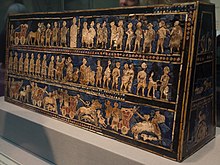
The Standard of Ur, in the British Museum.
The artifact was found in one of the largest royal tombs in the
Royal Cemetery at Ur, tomb PG 779, associated with
Ur-Pabilsag, a king who died around 2550 BC.
[1] Sir
Leonard Woolley's excavations in
Mesopotamia
in 1927–28 uncovered the artifact in the corner of a chamber, lying
close to the shoulder of a man who may have held it on a pole.
[2] For this reason, Woolley interpreted it as a
standard, giving the object its popular name, although subsequent investigation has failed to confirm this assumption.
[3]
The discovery was quite unexpected, as the tomb in which it occurred
had been thoroughly plundered by robbers in ancient times. As one corner
of the last chamber was being cleared, a workman spotted a piece of
shell inlay. Woolley later recalled that "the next minute the foreman's
hand, carefully brushing away the earth, laid bare the corner of a
mosaic in lapis lazuli and shell."
[4]
Plan of grave PG 779, thought to belong to
Ur-Pabilsag. The Standard of Ur was located in "S"
The Standard of Ur survived in only a fragmentary condition. The
ravages of time over more than four thousand years caused the decay of
the wooden frame and
bitumen glue which had cemented the mosaics in place. The soil's weight crushed the object, fragmenting it and breaking its end panels.
[2]
This made excavating the Standard a challenging task. Woolley's
excavators were instructed to look for hollows in the ground created by
decayed objects and to fill them with plaster or wax to record the shape
of the objects that had once filled them, rather like the famous
plaster casts of the victims of
Pompeii.
[5]
When the remains of the Standard were discovered by the excavators,
they found that the mosaic pieces had kept their form in the soil, while
their wooden frame had disintegrated. They carefully uncovered small
sections measuring about 3 square centimetres (0.47 sq in) and covered
them with wax, enabling the mosaics to be lifted while maintaining their
original designs.
[6]
Description
The present form of the artifact is a reconstruction, presenting a best guess of its original appearance.
[2]
It has been interpreted as a hollow wooden box measuring 21.59
centimetres (8.50 in) wide by 49.53 centimetres (19.50 in) long, inlaid
with a
mosaic of shell, red
limestone and
lapis lazuli.
The box has an irregular shape with end pieces in the shape of
truncated triangles, making it wider at the bottom than at the top,
along the lines of a
Toblerone bar.
[3]
Inlaid mosaic panels cover each long side of the Standard. Each
presents a series of scenes displayed in three registers, upper, middle
and bottom. The two mosaics have been dubbed "War" and "Peace" for their
subject matter, respectively a representation of a military campaign
and scenes from a banquet. The panels at each end originally showed
fantastical animals but they suffered significant damage while buried,
though they have since been restored.
Mosaic scenes
"Peace", detail showing
lyrist and possibly a singer
"War" is one of the earliest representations of a Sumerian army,
engaged in what is believed to be a border skirmish and its aftermath.
The "War" panel shows the king in the middle of the top register,
standing taller than any other figure, with his head projecting out of
the frame to emphasize his supreme status – a device also used on the
other panel. He stands in front of his bodyguard and a four-wheeled
chariot, drawn by a team of some sort of
equids (possibly
onagers or domestic
asses;
[7] horses were only introduced in the 2nd millennium BC after being imported from Central Asia
[8]).
He faces a row of prisoners, all of whom are portrayed as naked, bound
and injured with large, bleeding gashes on their chests and thighs – a
device indicating defeat and debasement.
[3]
In the middle register, eight virtually identically depicted soldiers
give way to a battle scene, followed by a depiction of enemies being
captured and led away. The soldiers are shown wearing leather cloaks and
helmets; actual examples of the sort of helmet depicted in the mosaic
were found in the same tomb.
[5]
The nudity of the captive and dead enemies was probably not meant to
depict literally how they appeared in real life, but was more likely to
have been symbolic and associated with a Mesopotamian belief that linked
death with nakedness.
[9]
The lower register shows four chariots, each carrying a
charioteer and a warrior (carrying either a spear or an axe) and drawn
by a team of four equids. The chariots are depicted in considerable
detail; each has solid wheels (spoked wheels were not invented until
about 1800 BC) and carries spare spears in a container at the front. The
arrangement of the equids' reins is also shown in detail, illustrating
how the Sumerians harnessed them without using
bits, which were only introduced a millennium later.
[5]
The chariot scene evolves from left to right in a way that emphasizes
motion and action through changes in the depiction of the animals' gait.
The first chariot team is shown walking, the second cantering, the
third galloping and the fourth rearing. Trampled enemies are shown lying
under the hooves of the latter three groups, symbolizing the potency of
a chariot attack.
[3]
"Peace" portrays a banquet scene. The king again appears in the
upper register, sitting on a carved stool on the left-hand side. He is
faced by six other seated participants, each holding a cup raised in his
right hand. They are attended by various other figures including a
long-haired individual, possibly a singer, who accompanies a
lyrist.
In the middle register, bald-headed figures wearing skirts with fringes
parade animals, fish and other goods, perhaps bringing them to the
feast. The bottom register shows a series of figures dressed and coiffed
in a different way from those above, carrying produce in shoulder bags
or backpacks, or leading equids by ropes attached to nose rings.
[3]
Interpretations
The
original function of the Standard of Ur is not conclusively understood.
Woolley's suggestion that it represented a standard is now thought
unlikely. It has also been speculated that it was the soundbox of a
musical instrument.
[2] Paola Villani suggests that it was used as a chest to store funds for warfare or civil and religious works.
[10] It is, however, impossible to say for sure, as there is no inscription on the artifact to provide any background context.
Although the side mosaics are usually referred to as the "war
side" and "peace side", they may in fact be a single narrative – a
battle followed by a victory celebration. This would be a visual
parallel with the literary device of
merism, used by the Sumerians, in which the totality of a situation was described through the pairing of opposite concepts.
[11][12] A
Sumerian ruler was considered to have a dual role as a
lugal (literally "big man" or war leader) and an
en
or civic/religious leader, responsible for mediating with the gods and
maintaining the fecundity of the land. The Standard of Ur may have been
intended to depict these two complementary concepts of Sumerian
kingship.
[3]
The scenes depicted in the mosaics were reflected in the tombs where
the "Standard" was found. The skeletons of attendants and musicians were
found accompanying the remains of the kings, as was equipment used in
both the "War" and "Peace" scenes of the mosaics. Unlike ancient
Egyptian tombs, the dead were not buried with provisions of food and
serving equipment; instead, they were found with the remains of meals,
such as empty food vessels and animal bones. They may have participated
in one last ritual feast, the remains of which were buried alongside
them, before being put to death (possibly by poisoning) to accompany
their master in the afterlife.
[14]
See also
References
Hamblin, William James. Warfare in the ancient Near East to 1600 BC: holy warriors at the dawn of history, p. 49. Taylor & Francis, 2006. ISBN 978-0-415-25588-2
- Cohen, Andrew C. Death
rituals, ideology, and the development of early Mesopotamian kingship:
toward a new understanding of Iraq's royal cemetery of Ur, p. 92. BRILL, 2005. ISBN 978-90-04-14635-8
External links
|
|
|---|
| Building |
|
|---|
Departments
and objects |
|
|---|
| Other |
|
|---|
|
|
Languages
The Standard of Ur, British Museum. Accessed 2010-12-05.
Zettler, Richard L.; Horne, Lee; Hansen, Donald P.; Pittman, Holly. Treasures from the royal tombs of Ur, pp. 45-47. UPenn Museum of Archaeology, 1998. ISBN 978-0-924171-54-3
Woolley, Leonard (1965). Excavations at Ur: a record of twelve years' work. Crowell. p. 86.
Collon, Dominique. Ancient Near Eastern Art, p. 65. University of California Press, 1995. ISBN 978-0-520-20307-5
Chadwick, Robert (1996). First Civilizations: Ancient Mesopotamia and Ancient Egypt. Editions Champ Fleury. ISBN 9780969847113.
Clutton-Brock, Juliet (1992). Horse Power: A History of the Horse and the Donkey in Human Societies. U.S.: Harvard University Press. ISBN 978-0-674-40646-9.
Gates, Charles (2003). Ancient Cities: The Archaeology of Urban Life in the Ancient Near East and Egypt, Greece and Rome. Routledge. p. 48. ISBN 9780415121828.
Bahrani, Zainab (2001). Women of Babylon: Gender and Representation in Mesopotamia. Routledge. p. 60. ISBN 9780415218306.
Settemila anni di strade. Milano: Edi-Cem. 2010.
Harrison, R.K. "Genesis", p. 441 in Bromiley, Geoffrey W. (ed.), International Standard Bible Encyclopedia: E-J. Wm. B. Eerdmans Publishing, 1982. ISBN 978-0-8028-3782-0
Kleiner, Fred S. Gardner's Art Through the Ages: The Western Perspective, p. 24. Cengage Learning, 2009. ISBN 978-0-495-57360-9
"The Standard of Ur". Smarthistory at Khan Academy. Retrieved March 27, 2013.











